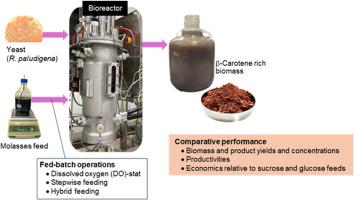利用未经处理的糖蜜培养富β-胡萝卜素酵母的分批补料策略
IF 3.8
Q2 BIOTECHNOLOGY & APPLIED MICROBIOLOGY
引用次数: 0
摘要
利用甘蔗糖蜜在22 l生物反应器中培养富含β-胡萝卜素的酵母红酵母CM33,并采用几种不同的补料策略:DO(溶解氧)-stat;逐步喂养;和混合进料(最初的指数进料阶段,然后是DO-stat操作)。研究了不同摄食策略对生物量、类胡萝卜素产量和养分转化效率的影响。分步饲喂被证明是最有效的,最终的干生物量浓度为73.1±2.7 g L−1;β-胡萝卜素滴度为181.9±1.0 mg L−1;生物量体积生产力为1.33±0.05 g L−1 h−1;β-胡萝卜素产量为3.31±0.02 mg L−1 h−1。然而,在这种饲喂方式下,糖和氮的转化效率最低,总糖的β-胡萝卜素产量为0.92±0.00 mg g−1,氮的产量为5.47±0.06 mg g−1。相比之下,DO-stat操作的资源效率最高,对糖的生物量产量为0.47±0.02 g g−1,对氮的生物量产量为2.64±0.05 g g−1,对糖的β-胡萝卜素产量为1.08±0.04 mg g−1,对氮的β-胡萝卜素产量为6.08±0.08 mg g−1。混合策略导致了各性能参数的中间值。原甘蔗糖蜜被证明是优良的高细胞密度培养的稻瘟病菌。β-胡萝卜素的商业化生产可能需要在生产力和资源利用效率之间做出妥协,特别是如果底物比产品贵的话。本文章由计算机程序翻译,如有差异,请以英文原文为准。

Fed-batch strategies for growing β-carotene enriched yeast Rhodotorula paludigena using untreated molasses
The β-carotene-rich yeast Rhodotorula paludigena CM33 was grown in a 22-L bioreactor using sugarcane molasses in combination with several distinct fed-batch strategies: DO (dissolved oxygen)-stat; stepwise feeding; and hybrid feeding (an initial exponential feeding phase followed by a DO-stat operation). The impacts of feeding strategies on biomass production, carotenoid production and nutrient conversion efficiencies were evaluated. The stepwise feeding proved most effective, achieving: a final dry biomass concentration of 73.1 ± 2.7 g L−1; a β-carotene titer of 181.9 ± 1.0 mg L−1; a biomass volumetric productivity of 1.33 ± 0.05 g L−1 h−1; and β-carotene productivity of 3.31 ± 0.02 mg L−1 h−1. However, with this feeding strategy the sugar and nitrogen conversion efficiencies were the lowest: the β-carotene yield on total sugar was 0.92 ± 0.00 mg g−1 and its yield on nitrogen was 5.47 ± 0.06 mg g−1. In contrast, the DO-stat operation was the most resource efficient, providing a biomass yield on sugar of 0.47 ± 0.02 g g−1, a biomass yield on nitrogen of 2.64 ± 0.05 g g−1, a β-carotene yield on sugar of 1.08 ± 0.04 mg g−1, and β-carotene yield on nitrogen of 6.08 ± 0.08 mg g−1. The hybrid strategy resulted in intermediate values of the various performance parameters. Raw sugarcane molasses proved to be excellent for high-cell-density culture of R. paludigena. A compromise between productivity and resource use efficiency may be required for commercial production of β-carotene especially if the substrate is expensive compared to the product.
求助全文
通过发布文献求助,成功后即可免费获取论文全文。
去求助
来源期刊

Biocatalysis and agricultural biotechnology
Agricultural and Biological Sciences-Agronomy and Crop Science
CiteScore
7.70
自引率
2.50%
发文量
308
审稿时长
48 days
期刊介绍:
Biocatalysis and Agricultural Biotechnology is the official journal of the International Society of Biocatalysis and Agricultural Biotechnology (ISBAB). The journal publishes high quality articles especially in the science and technology of biocatalysis, bioprocesses, agricultural biotechnology, biomedical biotechnology, and, if appropriate, from other related areas of biotechnology. The journal will publish peer-reviewed basic and applied research papers, authoritative reviews, and feature articles. The scope of the journal encompasses the research, industrial, and commercial aspects of biotechnology, including the areas of: biocatalysis; bioprocesses; food and agriculture; genetic engineering; molecular biology; healthcare and pharmaceuticals; biofuels; genomics; nanotechnology; environment and biodiversity; and bioremediation.
 求助内容:
求助内容: 应助结果提醒方式:
应助结果提醒方式:


